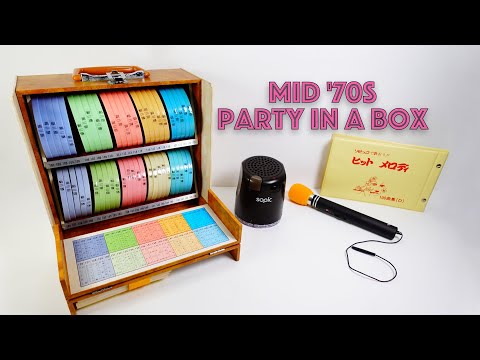Mid '70s party in a box

Okay so picture the scene it's 1976 you're sitting around the house you're a little bit bored you don't know what to do with yourself and then all of a sudden in comes uncle Mat and he brings this thing and he says don't worry everyone I brought a party in a box and of course the big question now is what exactly has he brought on the side of the box is the word Sopic inside the box we've got these individually numbered brightly coloured plastic discs they look a little bit like drinks coasters and in this section of the case I’ve got an index which details what is contained on each of these disks now for anyone that doesn't read Japanese or hasn't already figured out the purpose of this I’ll tell you this is a portable karaoke system yeah don't all switch off at once if you want to hang around I'll show you exactly how this works so of course the first job is to look for a song to sing along to we've got a hundred tracks on here there's 50 discs with a track on either side and if we look through the titles I can see there at 127 we've got the Green Green Grass of Home so we'll pick that one out so I'll just get disc 127 and along the top of each of the discs is the title and it's not that one of course obviously there we go that's the Green Green Grass of Home of course this is all down to my amazing Japanese abilities I can read this and nothing at all to do with Google Translate so that's the song that we want to sing so put that to one side so of course now we need the lyrics and those are contained in these booklets that are neatly stored in the bottom here these are identical to one another as far as the information on the inside goes so you can see there we've got the lyrics for each of these songs and since we picked out this one let's have a look what it is D23 so we just need to find 23 in here and there we go those are the lyrics to the song now these booklets are the ones that you'd hand around at a party there's the main booklet back here which has got the same information in it but just on larger sheets and they're contained in plastic so this is the one that you'd pass around perhaps use more often than not now I mentioned that this was D23 and the D signifies that this comes from set D there are multiple sets but this set was particularly well presented very clean with all the documentation included a really nice little box as well and this part here that's supposed to fold around like that so you can just have the index on the top and if we just turn it to one side it says Cap Record D so of course these things are known as Cap Records for rather obvious reasons and it's played back with one of these now I'll get it out of the box in a second I just want to mention along the bottom here though it says Japan Metals and Chemicals Co. Limited or JMC. Now that doesn't sound like the kind of company that would bring out a karaoke device and in fact JMC is still around nowadays and don't really seem to have any foot in the electronics business at all so let's just get it out of the box here we've got a nice carrying case and a microphone little earphone an ac adapter instruction booklet and a nice little orange piece for the end of that microphone there as well okay so we'll get the disc player out of its carrying case and this might ring a bell if you've been following this channel for a while that might look familiar we've got a speaker on the top an on off switch volume control and if we just open this section up this is the battery compartment because you can also run this thing on four AA’s as well as that AC adapter and the records go on the bottom here so this is the cap that comes with it that protects it but if we just to get one of these other cap records like this one here it just goes on there like that and the device is played in this position now inside the bottom here this section revolves that is the stylus and as it revolves it moves in towards the centre of the disc now I mentioned that this thing might look familiar so this is called the Sopic and previously on this channel I have featured the Panapic now at the time we looked at this we couldn't really figure out why it was called Panapic it makes more sense there because it comes from national of course Matsushita national Panasonic so if we can imagine the Pana bit being for Panasonic and the Pic bit well that's coming from here so this was Panasonic's version of the Sopic and this was a licensed product so the Sopic was the original that came out in the mid 70s this was the late 70s and I don't know if you remember how this one worked it used books like this now this is also a karaoke device so inside here each song has a nice picture to accompany it but also we've got the lyrics and we've got the disc for the device to play so you sing along with the music which is played back via this this just gets placed on top of the disc on the page and you plug your microphone into here and you can sing along it's often quite tricky trying to find the history of a product that was made just for the Japanese domestic market and it doesn't help in this case that Sopic is also the Selangor Oil Palm Industries Corporation, a Croatian ex-footballer, a liquid detergent and a village in Serbia. Fortunately the Karaoke Industry of Japan's website does have a page dedicated to the history of karaoke. Now incidentally there are two separate Japanese chaps that are generally credited with inventing the karaoke machine independently from one another around about 1969 they both used devices that played eight-track tapes and neither of these people patented their ideas and years later in the 1980s some chap in the Philippines managed to get that karaoke patent which then earns them a fortune each year but one of those original Japanese blokes this is the one who actually sold the first machines over there at the beginning of the 1970s he mentioned he didn't consider himself to be an inventor so he didn't patent anything because he'd actually just stuck together a few things that already existed a car stereo a coin box and an amplifier now one other interesting thing mentioned in this article is that the idea came to him after recording a backing tape for an event that he couldn't attend and he put this together for the president of a steel company now maybe that is the start of that connection between the Japanese metals and chemicals company and karaoke anyway back to the chart and I've copied across the first section of it thrown in the translator and this shows that the very first commercial karaoke machines went on sale in 1971. the first one being the handmade eight juke and I’ve highlighted that at the top left
in orange now the Sopic cap record system is shown here as being introduced in 1975. so this really is quite early it's just four years after those first hand hand-built machines from what I read in japan karaoke only really started to blow up around 1976 so the Sopic system really was there right near the beginning and riding that first wave of popularity I’ve put some batteries in it fortunately it is working but there is a bit of a problem with it at the moment it sounds like this yeah the audio keeps cutting out because there's some oxidisation on this volume pot so I need to be able to get to the back of that so I can spray some contact cleaner on it now fortunately along the base here there are four screws so it just looks a matter of taking those out and then removing the inside okay well that came out easily in fact the speaker came out a bit easier than it should have done because this is supposed to be stuck to the top but the adhesive that goes around there has just come loose so I'll stick it back in when I put it back inside the case but the volume I need to get to is there I'll still need to unscrew that to get to the other side of it to spray the contacts but the construction of this thing is uh really quite impressive I mean look how much metal is in here this is a a well-made piece of equipment but let's just get that volume pot out first and then we can have a look at it and there we go now I'll spray that with some contact cleaner in a second there's still some wires going up into the top here those just lead off to this power LED so we'll leave those in position right so I've got my contact cleaner and all I need to do is just spray a bit in here well quite a bit liberally really I've got some stuff down here to catch any over spill it'll evaporate as well so there's no danger of this damaging anything it's just a matter of working this volume pot up and down making sure that the contacts are clean I think that should do it let's let's find out well as far as fixes go you don't get much simpler than that just a bit of contact cleaner sprayed on there we've got no crackles at all now one thing I've noticed here as usual the motor has a date on it it's the 27th of December and then 70 and the last digit is a very oblique angle but I can make it out as a six so December 1976. now whilst I've got this open it's a good opportunity to be able to see how it all operates on the inside however if I was to play this disc you can't see through that so you wouldn't be able to see what the stylus is doing fortunately it did come with this clear disc which enables you to have a look through the bottom as well but just to show that the disc isn't the thing that's revolving it's actually the mechanism I'm going to put a sticker on here because it does have a bit of an optical illusion effect it looks like you've got a revolving disc so if we put a line on there you'll be able to see that that's not moving and we'll just pop this on here and face it towards the camera so I think you can make that out there that's my line of tape now this sticker here that is actually on the mechanism on the inside so you can see how it all moves in a second so we'll press play this is a demonstration of various percussion sound effects not the most interesting disc but at least you can see how the mechanism works a little bit better this is the motor here there's the drive shaft it's going on to this rubber wheel here well it's plastic wheel with a rubber ring around the outside there's another smaller ring on the bottom and that's coming into contact with this large wheel here and then that goes through into the bottom and that spins around the whole stylus mechanism but as you can see it really is very well put together I mean this is a a quality piece of equipment I'm just peeling a bit of this double-sided tape off because I intend to replace this before I stick it back inside the case right so we've got the playback working fine on this now but the next question is how do you use it as a karaoke machine because if you look at the inputs on the side here we've got a power in and an earphone out no mic in and there's no other socket on it anywhere and the answer to that is no doubt this that was also in the box this is an FM microphone if we look at the wire that's on here you can see that's an antenna it's not designed to be plugged into anything and if we look at the options available on here well we've got off position there and then mic there and FM mic here and then auxiliary there so it does multiple things now if you were to just turn it into the mic mode there's a socket on the bottom here so you will be able to wire it into something else via that but not this device because it doesn't have the appropriate input so this is no doubt supposed to be used with the FM mic mode by the way the auxiliary at the bottom there that also lets you plug something into here to then be transmitted out via this out over FM and then you could pick it up on a normal radio in fact this is a quality piece of kit here because if you look at the bottom it's made by Marantz although it is especially for the Sopic device now here we've got the frequency adjustment this is to adjust the FM output so 76 up to megahertz and I've got no idea whether this thing is on when I turn it into the FM mic mode because there's no LED anywhere on it and also if I try and talk over it or make any noise it's just not coming through to here at all so I'm going to have to test this with something else fortunately I've got a couple of Japanese radios in the house so I'll be able to find something that will pick up the frequency this is transmitting on if it is transmitting and then if we know this is working then we can perhaps retune it to communicate with this thing oh by the way I have swapped the batteries out in this in the bottom here it just takes one AA there so iIm hoping it's working let's get a radio out and find out and if this is working it should be relatively easy to find out what frequency is transmitting on because we won't hear this annoying hiss it should just come through as silence ah I think we might have hit it but oh no is that it 77.9 no close 78 let's try that hello check check check yeah I think we think we're through there now let's turn this up okay mic check one two what is this yeah it's working fine so I've been reading through my instructions for the Sopic S100 and it turns out this thing doesn't have an FM receiver in it at all no the mic is designed just to tune into your radio and this is designed to have its audio either output through the built-in speaker or via that earphone socket and there was one of those little earphones included inside the box so of course you could mix those two things together externally you could send your audio out from this into something like this with an auxiliary input and then you could plug your microphone into the mic socket on the front here and I can mix them together like that but yeah it wasn't as sophisticated as I thought however this is the S-100 that's the first one the S-200 did have a mic input on it and it just so happens that the Panapic from National was based on the S-200 and therefore as well as the audio out we've got a mic in on here so we can actually plug a mic into this one and use this as an all-in-one karaoke device so I think we should switch over to this and I want to just play you a few samples from these discs just to give you an idea as to the quality of the background-music I don't know if you recognised any songs that were being played there I certainly didn't and in fact when I looked through these to try and find which songs I did recognise I played through them all and there's only a few that have tunes that I know and that's not surprising of course these are songs that were popular in japan and they go back some of them to the 1950s all the way through up to the 70s and as someone who wasn't brought up in Japan with the history there these are unfamiliar to me there are a couple that I do know now there's My Way which is infamous for people being shot when they're singing and I have previously sung that one well ‘sung’ in one of these other karaoke demonstrations and we mentioned the Green Green Grass of Home now that one I managed to find it by looking at the name of the writer of the song but it actually has it wrong on here it says Cuzly Putman but I put that in and it corrected it to Curly Putman and that brought me through to the song of course the titles of these aren't always a direct translation as well there's a couple of others I managed to find in a similar way because if you look through the book here you can find the names of the people who wrote the song and if those are in English there's a good chance that that will be something that I'm slightly familiar with the truth is there are only a couple in here and there's one if we get this one here which I'm unfamiliar with if I can get it out but it's more famous in France there's a song called Champs-Élysées now the Champs-Élysées was a hit this wasn't this is called Waterloo Road but because of the names of the people that wrote it on here that's how I managed to identify that so I think we'll have a go with Waterloo Road okay in true 1976 style I've got the lyrics here on my phone now just one thing I wanted to mention before I start off I'm sure some people might think that perhaps if I put this in the auxiliary mode I'll be able to feed the audio in from the disk and then also transmit it out over to a radio while speaking into the microphone No it doesn't work that way just auxiliary only or mic only but you can't mix the two things together so what I'm doing here I've just plugged the mic into the back of this one so we're not using the FM side of it at all just using it as a normal mic and my voice will be coming out through this speaker here along with the music one thing to say about this though I realised that you know nowadays you get those karaoke devices with a little ball that would follow along or the text would highlight the bit that you're supposed to sing if you're unfamiliar with the song it's a little bit tricky to know the speed that you should be going at but this one I've listened to it a couple of times and I think I've got a bit of a gist for it now so let's give it a go and I should mention this song has a whole kind of chirpy chappy cockney music-hall type vibe to it or at least it did on the versions that I've listened to so I'll try my best to emulate that but I'm not great with accents Walking down the street today I saw a girl across the way I asked her where she's going she said come with me and then we stopped and chatted as we passed the time away I think that's enough of that there's just one last job to do before I go we might as well create the thumbnail for this video so we need to take this out of the scene because it doesn't belong with this set and we might as well pop the disc back inside the box keep it all neat and tidy bring in the original Sopic S100 and the lyrics book as well and there you have it that is your mid-1970s karaoke party in a box I hope you've enjoyed having a look at this here today but that's it for the moment as always thanks for watching
2021-07-18 02:54


